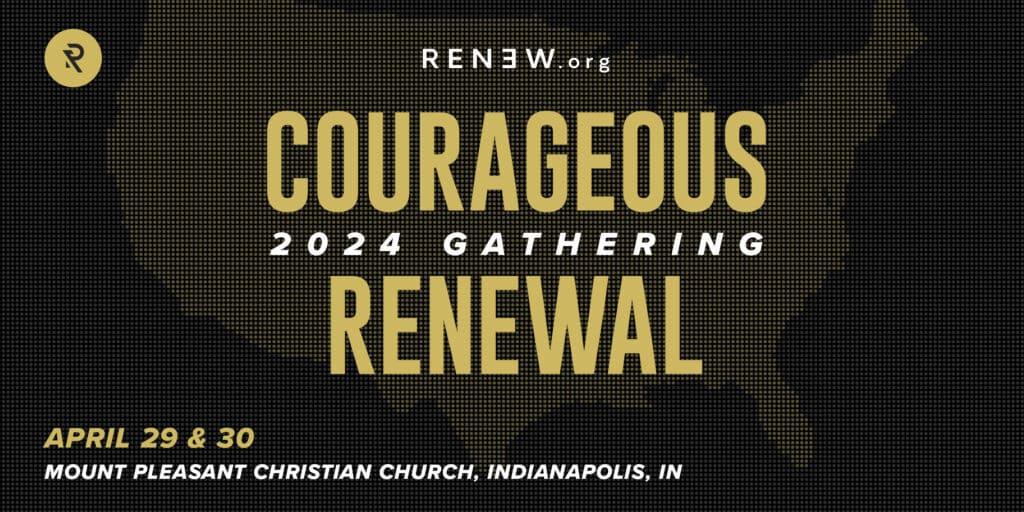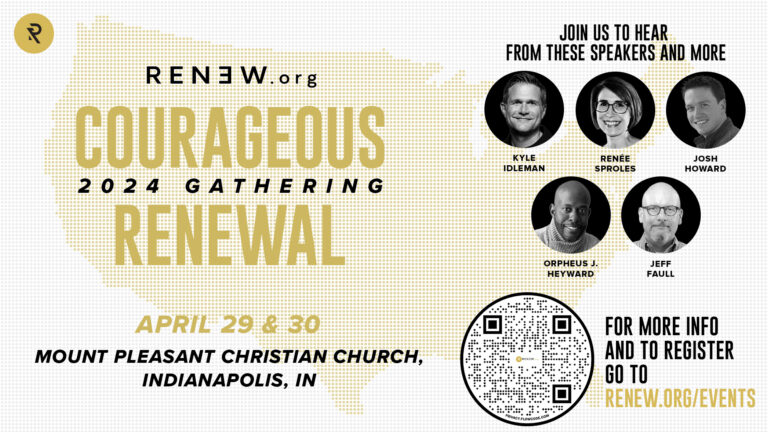The Restoration Movement spread throughout the American frontier in the early nineteenth century out of the Second Great Awakening. Its leaders emphasized Christian unity based in the Scriptures, although it has since branched into a vast spectrum of liberal to conservative streams. In an era of historical apathy and illiteracy, what can those of us with Restoration Movement roots gain from looking back at our history? I recently caught up with Rick Cherok, History Professor at Ozark Christian College, and asked him to explain the movement’s rise and plateau and to remind us of lessons we can learn from the movement’s history.
Q. What societal factors help explain the rapid growth of the Restoration Movement in the first decades?
There were certainly some cultural factors that played an important role in the growth of the Restoration Movement. A few years back, I taught a seminar on the Restoration Movement at a church in the Cincinnati area. As I taught about some of the background events that came together to help promote this movement, I recall one minister asking, “But don’t you see this as a miraculous movement of God?” I agreed that God was involved with the movement, but I tried to explain that God often works through the unfolding of historical events. A few of those historical ideas that were influential to the growth and development of the Restoration Movement were primitivism, millennialism, and Christian reform.
With that said, I think it’s important to recognize that the Restoration Movement’s beginning in the early 1800s was right on the heels of the founding of the new American nation. As the new nation was establishing itself in the late 1700s, the Founding Fathers were trying to figure out the best possible manner for governing this new country. In this effort, they searched the political theories, ideas, and histories of the ancient civilizations (primarily Greece and Rome) with the hope of establishing a governmental system that would endure the test of time.
Restoration Movement History: “The Restoration Movement’s beginning in the early 1800s was right on the heels of the founding of the new American nation.”
This notion of looking back upon the wisdom of the ancients, a concept that we now know as primitivism, influenced not only the early American culture, but also bled into the thought of the church. The Restoration Movement has been significantly influenced by this idea. As a result, the early leaders of the Restoration Movement capitalized on the cultural concern for primitivism by suggesting that they return to the ancient gospel and the early church as found in the pages of New Testament. This notion resonated with many people in the early 1800s.
Moreover, in the decades that directly followed the conclusion of the War of 1812, a period often referred to as the “Era of Good Feelings,” many Americans began to be almost giddy about the existence and future of their nation. Not only had the young nation survived the War of Independence, but they had also survived the Second War of Independence (i.e., the War of 1812) and things appeared to be looking up for the new country.
As they built roads, schools, bridges, canals, and other infrastructure, many Americans became convinced that they were on the cusp of the long-expected Millennium (cf. Revelation 20). This period of positive feelings was so powerful that when President James Monroe ran for a second term in office, he ran unopposed because the country appeared to be satisfied with his service. The progress Americans observed in their society, coupled with a strong sense of postmillennial optimism, inspired many to believe they were living in a unique period in which God had special plans for both the nation and the church.
Restoration Movement History: “The progress Americans observed in their society, coupled with a strong sense of postmillennial optimism, inspired many to believe they were living in a unique period in which God had special plans for both the nation and the church.”
This interest in the millennium had a profound impact on society at large and upon the leaders of our early movement. One need only read the newspapers of the early nineteenth century to see that a widespread expectation of a coming millennium was at hand. Even unbelievers like the deist, Robert Owen, were convinced that the social improvements he saw all around him were leading to something of a secular sort of millennium (i.e., a millennium without God). Nearly all of the early Restoration Movement leaders were convinced that such a millennial period was at hand. Alexander Campbell was so convinced that the millennium was near that he named his magazine the Millennial Harbinger, implying that the ideas espoused in his movement were helping to announce and bring about the millennial period.
In an effort to hasten the onset of the golden millennial era, many Americans engaged in a number of antebellum reform movements with the idea of further perfecting their society. Among the reform activities that gained attention during this age were the anti-slavery movement, the temperance movement, educational reforms, prison reforms, and many others. And it was within this context that many people saw Campbell’s call for returning to the New Testament vision for the church as something of a Christian reform movement.
Unlike some of the other social reforms that were taking place, Campbell did not say, “let’s change Christianity and make it better,” but “let’s get Christianity back to what it was originally as found in the pages of the New Testament.” This vision of Christian reform had a great appeal that brought throngs of people to an acceptance of Campbell’s goal for renewing the church of the first century.
Restoration Movement History: “This vision of Christian reform had a great appeal that brought throngs of people to an acceptance of Campbell’s goal for renewing the church of the first century.”
Q. What religious factors were at play during the early years of the Restoration Movement?
Perhaps as much as anything, the early Restoration Movement had a number of incredible evangelists who were sold out on the idea of preaching the ancient gospel as found in the New Testament. Evangelists like Walter Scott, “Raccoon” John Smith, John T. Johnson, and many more traveled throughout the country proclaiming the gospel message with incredible success. Their desire was not to grow a particular congregation, but to advance the Kingdom of God throughout the country.
Keep in mind that the early Restoration Movement developed right in the midst of a huge national revival known as the Second Great Awakening. This Second Great Awakening introduced a period of revival that was already sweeping through the young country as the Restoration Movement took form. In fact, the ethos of the Restoration Movement seemed to mirror the national ethos of the awakening as something of a return-to-God mentality converged upon the country. As the revival unfolded, the early advocates of the Stone-Campbell Movement were right at the heart of it.
Restoration Movement History: “The early Restoration Movement developed right in the midst of a huge national revival known as the Second Great Awakening.”
To some degree, there was also an entertainment value that accompanied the activities that make up the early history of the Restoration Movement. Within the context of the early nineteenth century, when television, radio, and internet did not exist, things like the Cane Ridge Revival and the Campbell debates were social events that attracted huge crowds of people who attended for the experience but also heard the message being offered. When Barton Stone hosted the revival at Cane Ridge, he said a military man estimated the crowd at over 30,000 people. While that may be something of an overestimate, it was definitely a significantly large audience. Also, as Campbell debated Robert Owen, the crowds were so large that people were shuffled in and out of the auditorium to allow others to hear the unfolding event. Spectacles of this type brought people together to witness the great event, but these events allowed the message of the movement to gain momentum.
There was also an educational facet to the early success of the movement. From its start, the Restoration Movement sought to disciple, train, and equip people for service very quickly. It’s interesting to note that in the early decades of the nineteenth century, a person could declare themselves a medical doctor by simply hanging out their shingle and beginning to practice. Yet, if you wanted to be a minister, there was a myriad of theological hoops and exams to pass through before a person could be licensed and ordained. But as the Restoration Movement began to emerge, they stressed the simplicity of the gospel (rather than mystical approaches to Scripture or deep theological questions) as the every-person approach to reaching the world.
In fact, the early proponents of the movement saw it as an “anybody-can-do-it” approach to evangelism. They encouraged everyone to study Scripture and to tell others about Christ. This does not mean that people like Campbell, McGarvey, Milligan, and others saw no value in acquiring a biblical education. They certainly stressed this notion as important, but insisted that one should not wait for degrees, ordinations, or licenses before entering into the work of advancing the Kingdom.
“One should not wait for degrees, ordinations, or licenses before entering into the work of advancing the Kingdom.”
This every-person approach to evangelism grew the Restoration Movement to an estimated 30,000 people by 1830. More importantly, however, this movement continued to add more and more converts over the next seventy years. In the nineteenth century, the movement became the fastest-growing religious movement in the United States. The growth was predominantly in the frontier areas of the Midwest: Kentucky, Virginia, Western Pennsylvania, Ohio, Tennessee, Indiana, Illinois, and Missouri, but there were also numerous congregations in Oregon, California, and throughout the other areas of the country.
Q. When and why did the Restoration Movement begin to plateau?
Although Alexander Campbell held no official position or office of leadership within the early Restoration Movement, he was certainly the most influential individual in the movement during his lifetime. In some ways, Campbell was something of a Billy Graham type of figure who was both a recognized and esteemed figure within both the movement and American Christianity at large toward the latter years of his life. As something of a de facto leader in the movement, Campbell was able to hold the movement together—even amid emerging factions—until after his death in 1866.
Once Campbell had passed away, many of the issues that marked the late-nineteenth century in the Restoration Movement (and to some degree in American Christianity) brought about not only an eventual plateauing in the movement’s growth, but ultimately two divisions within the movement. The first division is generally dated at 1906 when the instrumental (Disciples of Christ) and non-instrumental (Churches of Christ) segments of the movement identified themselves as two distinct groups.
The second division began about two decades later but was a much slower process that took many years to complete. It ultimately brought about the formation of the Disciples of Christ and the Independent Christian Churches and Churches of Christ. As the Disciples became more accepting of theological liberalism and a missionary society that adopted the principles of theological liberalism, the more conservative wing of the Disciples began to promote direct-support missionaries that were independent of the single society known as the United Christian Missionary Society. These “independents” would later identify as the Christian Churches/Churches of Christ.
Restoration Movement History: “The divisions appear to have been predicated upon the regional divisions that emerged in early American politics and the intensification of this sectionalism that rose out of the Civil War.”
While there were certainly issues and concerns that ultimately led to the divisions that occurred in the early twentieth century, the divisions appear to have been predicated upon the regional divisions that emerged in early American politics and the intensification of this sectionalism that rose out of the Civil War. And, while congregations from each segment of the various divisions can be found in various regions of the country, the movement basically divided into northern, southern, and western regions of numerical strength.
The southern region, which would ultimately become the non-instrumental Churches of Christ, formed around the influence of David Lipscomb and the Gospel Advocate in Nashville, TN. The Christian Standard, Isaac Errett’s magazine which was published in Cincinnati, OH, eventually gained prominence among the movement’s northern constituents who eventually became the Christian Churches/Churches of Christ. And J.H. Garrison’s periodical, the Christian-Evangelist, which was published in St. Louis, MO, would eventually have its greatest influence among the Disciples of Christ and the western region.
As each of these segments of the movement emerged, they appeared to focus their efforts on sustaining and upholding their positions. Amid the era just before and during these divisions, one of the greatest problems of the Restoration Movement was that they began to look primarily through the lens of who’s right and who’s wrong, while abandoning the call to pursue unity. Moreover, the goal of reaching the world for Christ seems to have taken a backseat to the claims of exclusivism. And so, the movement lost the momentum it had in the previous century.
Q. What in Restoration Movement history are we most in danger of forgetting?
Last year at ICOM (2021), I was one of the keynote speakers. The topic I was asked to address was the Restoration Movement and our culture today. In my sermon, I read a quote from Isaac Errett, one of the most important second-generation leaders of the movement. To Z.T. Sweeney, another great preacher in our movement’s history, Errett remarked, “The greatest fear I have for our movement is that we may raise up a generation of preachers who will not understand what we are trying to accomplish.” In many ways, that day has come. We have forgotten both the genius of our movement and what the Restoration Movement is all about.
“We have forgotten both the genius of our movement and what the Restoration Movement is all about.”
This movement was built on the concept of “unity in truth,” but it goes well beyond this. The early leaders of the movement sought more than simply unity or truth. Their desire was to reach the world for Christ. While the concepts of Christian reform and millennial optimism may not exist today, these notions prompted the early advocates of the Restoration Movement to do the work of evangelism. Bringing the lost to salvation was the goal of the early movement.
Within the Restoration Movement’s past, some have come to believe that the only goal of the movement is unity, and so they’ve become all things to all people in a misguided way that sees no value in biblical truth. On the opposite side of that coin, however, some have concluded that the movement’s ultimate goal is restoring New Testament truth—especially as they see it. This view allows for no differing perspectives or understandings.
The original goal of the movement, as expressed in Jesus’ prayer in John 17, however, is that his followers would be sanctified in truth and unified in service so “that the world may believe” (John 17:21). Unity and truth are a means toward an end: to win the world to Christ. That’s what the church is about and what the Restoration Movement was meant to be about. We cannot allow unity that discards truth, nor truth that abandons unity by focusing on individual opinions, to outweigh the ultimate goal of winning the world to Christ.
Restoration Movement History: “Unity and truth are a means toward an end: to win the world to Christ.”
Q. So, what is our Restoration Movement heritage?
This is a good question and one that we’re in danger of losing. In the first chapter of 2 Timothy, Paul noted that his young companion’s “sincere faith” had derived from the influence of his grandmother and mother. In essence, Paul was offering a note of appreciation for Timothy’s background and his roots in the faith that had come from this background and had profoundly influenced Timothy. I wonder if many of our churches today respect their background and the roots that have influenced them.
From all indications, many of our churches no longer see any value in teaching church members about our heritage and the Restoration roots that influence our Christian tradition. Far too many people within our churches have no concept of our movement or what it means or stands for. Moreover, some of our churches, especially some our megachurches, seem to have distanced themselves from their Restoration Movement in an effort to align themselves more closely with other megachurches, regardless of their background. Some churches are even hiring staff who have no knowledge of the Restoration Movement and some of our colleges have even abandoned classes that provide instruction in our Restoration background.
Because our heritage is like an anchor that holds us steady and prevents us from being swept away into an ocean of ideas and philosophies, one must wonder if those who have abandoned their Restoration heritage are setting themselves and others up to simply drift off into who knows what.
“When we cast our heritage aside, we’re losing what made us what we are.”
When we cast our heritage aside, we’re losing what made us what we are. That’s a general truth that’s demonstrated throughout Scripture. God repeatedly told the ancient Israelites to remember who they were and what God had done for them. In Exodus 12, they were told to remember the Passover and celebrate this event, in Deuteronomy 11 they were told to remember God’s mighty work and to instruct their children about it, in Joshua 4 they were told to stack up stones from the Jordan River as a reminder of God’s parting of the water, and there are plenty of other instances in Scripture where God’s people are told to remember the past. There’s a definite value that comes from being aware of our heritage.
Occasionally I hear people say, “I just want to be a Christian; I don’t need to remember this or that heritage….” But where did the idea of “just being a Christian” come from? Isn’t it because someone within a tradition like the Restoration Movement suggested that we be Christians only who take the Bible only as our rule of faith and practice? It’s from our heritage. And if we do not continue to promote that heritage, will the next generation remember it or will they drift away to other ideas that seem pragmatic or acceptable?
“If we do not continue to promote that heritage, will the next generation remember it or will they drift away to other ideas that seem pragmatic or acceptable?”
So…what is our heritage? It’s much more than a brief discussion can explain, but if I were to offer a quick synopsis of our movement’s overarching philosophy, I would suggest that the Restoration Movement is a response to Jesus’ prayer in John 17 calling for unity and truth so that the world can be won to Christ. There’s a natural and obvious tension between unity and truth, as I’ve mentioned above (unity can become an “anything-goes” faith, while truth can degenerate into an “I’m-the-only-one-who’s-right” mentality), so there has to be some give and take on either end in order to keep our focus on the ultimate goal of winning the world to Christ.
In a 1967 interview with Christianity Today, Dr. Elton Trueblood, a Quaker theologian, referred to historical amnesia as the “Disease of Contemporaneity” and called it one of the greatest problems that confronts modern society and the church. He went on to relate a story about a group of ministers who approached him about some challenges to their ministries. When Trueblood suggested they read a few classical writings from Christian history, one minister explained that these books were from another era and would be of no value today.
Trueblood then noted that the men had “not really considered carefully enough the nature of the human problem.” He went on to suggest that a person can hate his neighbor just as easily while riding in a modern jet plane as in an ancient cart being pulled by a donkey. The point Trueblood was illustrating is that our heritage is more than just the past, it’s a guide that both teaches us and directs us in our present lives.
Restoration Movement History: “I would suggest that the Restoration Movement is a response to Jesus’ prayer in John 17 calling for unity and truth so that the world can be won to Christ.”
Q. What else could be lost by forgetting our heritage?
One of the early Restoration Movement slogans that gained great popularity among the early advocates of the movement was “Back to the Book.” In a lot of ways today, it seems, we give this idea some lip service, but we really don’t support it. It’s so easy for modern churches to simply jump on the bandwagon of the latest fad without actually measuring the fad or our actions against Scripture. In fact, it almost seems as though our desire for success (as we define it) leads us to operate on the basis of, “This looks like a good idea, so how can I use Scripture to back it up?” The early advocates of the movement didn’t try to support their ideas through Scripture; they tried to develop their ideas from Scripture. We need to do this as well.
Another early slogan we would do well to remind ourselves of is that “We are not the only Christians, but we are Christians only.” God didn’t set us up to judge the world. Yet, sometimes we’ve been downright nasty with people because they don’t agree with us in every little point. The idea of simply being Christians, without seeing ourselves as the only Christians, is a powerful witness to the unbelieving world. There’s so much division in our world that any actions that demonstrate unity are impressive. This does not mean that we need to surrender any of our beliefs or convictions; it simply means we should treat others who claim to follow Christ—even if we disagree with them on issues—as our brothers and sisters in Christ.
If God commands us to love our enemies, certainly we can love others who claim belief in Christ, even if we have areas of disagreement. The Restoration Movement teaches us to focus on the essentials of the Christian faith while allowing others to have differences of conviction in the nonessentials of the faith, and to still love each other even if we disagree.
“If God commands us to love our enemies, certainly we can love others who claim belief in Christ, even if we have areas of disagreement.”
Reminding ourselves of these core convictions could really help us navigate these confusing times, while providing direction and motivation for the movement. Yet we often cast such ideas aside as unimportant. There really is an appeal to seeking unity in truth that the world may know Jesus. People resonate with these concepts as much today as perhaps in any time.











